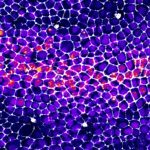Link to Pubmed [PMID] – 26898471
Link to DOI – 10.1016/j.cub.2015.12.072S0960-9822(16)00059-2
Curr Biol 2016 Mar; 26(5): 670-7
Regulation of tissue size requires fine tuning at the single-cell level of proliferation rate, cell volume, and cell death. Whereas the adjustment of proliferation and growth has been widely studied [1-5], the contribution of cell death and its adjustment to tissue-scale parameters have been so far much less explored. Recently, it was shown that epithelial cells could be eliminated by live-cell delamination in response to an increase of cell density [6]. Cell delamination was supposed to occur independently of caspase activation and was suggested to be based on a gradual and spontaneous disappearance of junctions in the delaminating cells [6]. Studying the elimination of cells in the midline region of the Drosophila pupal notum, we found that, contrary to what was suggested before, Caspase 3 activation precedes and is required for cell delamination. Yet, using particle image velocimetry, genetics, and laser-induced perturbations, we confirmed [6] that local tissue crowding is necessary and sufficient to drive cell elimination and that cell elimination is independent of known fitness-dependent competition pathways [7-9]. Accordingly, activation of the oncogene Ras in clones was sufficient to compress the neighboring tissue and eliminate cells up to several cell diameters away from the clones. Mechanical stress has been previously proposed to contribute to cell competition [10, 11]. These results provide the first experimental evidences that crowding-induced death could be an alternative mode of super-competition, namely mechanical super-competition, independent of known fitness markers [7-9], that could promote tumor growth.


